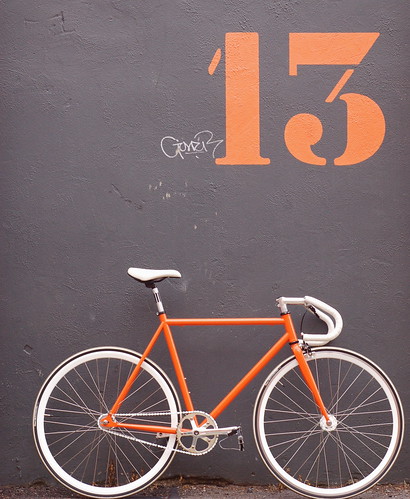To brake or not is the raging debate among “fixies” ! Sort of dumb and super hip (read Hollywood), fixed-gear bicycle fever spreads
(Source: Washington Post)
They don’t make much sense, yet for one more fleeting season at least, they are the rage in certain circles. Sort of dumb and super hip: the twin characteristics of many things in life.
We are talking about a bicycle. A very special kind of road bicycle, called a fixed-gear bike, or fixie for short.
A fixie has one speed, which makes it difficult to pedal uphill. A classic fixie has no brakes, which makes it difficult to slow on the downhill. A fixie has no freewheel, the part that makes coasting possible. Instead, the chain directly drives the rotation of the rear wheel, which means the pedals always turn while the bike moves.
What else do they have going for them?
Well, fixies are impractical, perverse throwbacks to a time more than a century ago, before the invention of the derailleur and the Tour de France, when the bicycle chain and the pneumatic tube were novelties, and the high-wheel penny-farthing “ordinary” bicycle had just been eclipsed by the chain-driven “safety” bike.
And yet despite all that — or is it because of all that? — a fixie manages the neat trick of simultaneously communicating taste and rebellion.
Washington was a little behind the curve in adopting this fixie chic. Some date the dawn of fixie chic to the 1986 movie “Quicksilver,” starring Kevin Bacon, which glorified fixie-riding messengers in New York.
Countercultural couriers and speed-demon messengers didn’t invent fixies. The inspiration was handed down to them by the obscure yet mighty gods of the velodrome, who race indoors on one-speed brakeless track bikes. Fixies take the track bike concept and relocate it to city streets.
A fixie map of Washington would center on a handful of neighborhoods. Your fixie is what gets you from your futon in Columbia Heights to your computer screen downtown, then on to peruse the produce and fiction in Logan and Dupont circles, finally delivering you to an outdoor table on U Street NW, a rope line on H Street NE or a bike polo match at Eastern Market. Fixies haven’t made it in a big way to the suburbs, and may never, for strictly topographical reasons. They aren’t good over long hilly distances.
Fixie riders also talk about achieving a sense of “flow” as they navigate streams of cars. They describe a kind of “dance” set to the rhythm of traffic lights. You can’t coast through life on a fixie.
The euphoric riding experience is achieved via the discipline of the fixie’s low technology. In zealous self-denial, a fixie rider experiences more with less. The reason you have to be super-aware of your surroundings and think ahead is because stopping can be a challenge. Fixie riders are like sharks, constant motion is an existential requirement.
Fixies are built for speed, but if you must slow down, one way to do it is to resist the pedal momentum with your leg muscles and knees. (Your poor knees.) Toe clips or cleats help you pull back on the pedals. A more dramatic recourse is the skip-stop, which involves leaning forward, hopping the rear wheel and locking one leg to start a skid when the rear wheel comes down. In the unlikely event your chain falls off, you will be a helpless, speeding missile with only a helmet for protection, if you wear one. Some do, some don’t.
To brake or not to brake is a debate within the fixie community to which conventional bikers can listen only with astonishment.
Riding without brakes gives an extra edge to the riding experience.
“It’s definitely more dangerous,” says David Waterman, 27, a high school math teacher locking his brakeless fixie one night outside the Black Cat on 14th Street, where seven of 15 bikes parked before the show are fixies. He prefers muscle power to skidding as a slowing strategy, because skidding wastes tires. But, he allows, “You look really cool when you skid.”
Click here to read the entire article.

